Connecting a hard drive via USB. Connecting a hard drive (hard drive) via USB
It is not necessary to remove a hard drive from a computer case very often, but such situations still occur. For example, when you collect new computer or decided to upgrade your hard drive. The old hard drive will be placed on a shelf, after which you suddenly discover that there are still necessary files. Moreover, when any files are required, they are needed urgently. And you have to crawl under the table, open the computer wall and connect the hard drive. It would be nice if you always had an adapter from SATA/IDE to USB 2.0 at hand. Like the one offered by Brando.
Today you can find a lot on the market motherboards, allowing you to connect a hard drive without disassembling the case. Of course, the eSATA (external SATA) standard is perfect for this, but many users today use their own solutions. For example, take SATA and power cables outside. Gigabyte can be cited as an example: the company has been supplying external SATA cables (not eSATA) with motherboards for quite some time.
But the problem is how to supply power to the drive. You can buy two or three Molex extension cords or tees and route the power outside the case. But this option is not the most convenient and safe: the wires do not look aesthetically pleasing, and if you “try hard”, you can try to insert the connector “upside down” and burn the drive. The drive does not receive proper cooling from the outside, and if your dog, for example, throws off or knocks over a working hard drive, it can easily “die.”
For proper operation, hard drives should always be in some kind of mount or rack. Therefore, we recommend acquiring special equipment or external hard drive. The Brando company recently introduced an interesting adapter from SATA/IDE to USB 2.0, which allows you to connect Serial ATA or UltraATA hard drives via USB.

Inside the cable plug there is logic that converts signals and protocols from Serial ATA or UltraATA interfaces to USB 2.0. The illustration shows a connector for 2.5" hard drives.
Unfortunately, finding a Brando adapter in Russia is not so easy. However, there are other more or less similar models, so our review, to one degree or another, also applies to them.
Inside the box we found an adapter cable with a USB plug at one end and a compact module at the other. The module provides one Serial ATA port, one 40-pin UltraATA interface and a 40-pin HD (high density) UltraATA connector for 2.5" hard drives. But remember that you can only connect one drive at a time.
There were problems with the high-density UltraATA connector: it did not work with any 2.5" drives Western Digital and Fujitsu, nor with a 1.8" hard drive from Hitachi. However, the SATA and UltraATA interfaces worked completely fine. For 2.5" hard drives, we decided to arm ourselves with an adapter for a 40-pin ATA connector. Finally we decided to connect Serial ATA optical drive from MSI two years ago, which also worked fine.
The combination of Brando adapter and hard drive is determined by the computer as external storage USB 2.0 and works without any drivers. However, USB interface 2.0 does not provide the high transfer speeds that modern drives are capable of. To test the performance of the adapter, we used c"t h2benchw. Read performance turned out to be about 30 MB/s, and write performance was almost 27 MB/s. Actually, this is exactly the level we expected from high-speed USB devices 2.0.
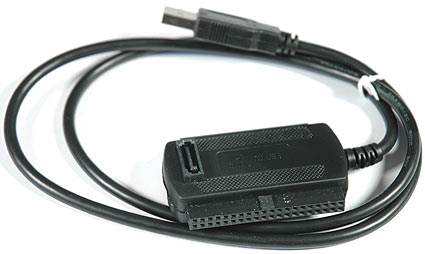
On the other side of the module there is a 40-pin UltraATA connector.
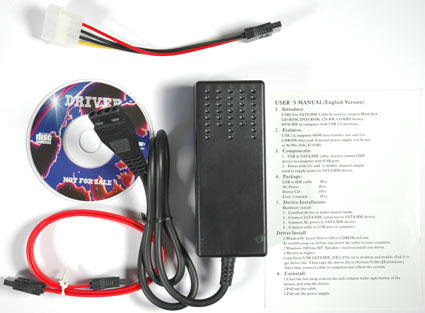
Brando supplies the adapter with a small power supply, a Molex to SATA power adapter, a Serial ATA cable, and a software CD. There is also a small instruction, but we didn’t need it.
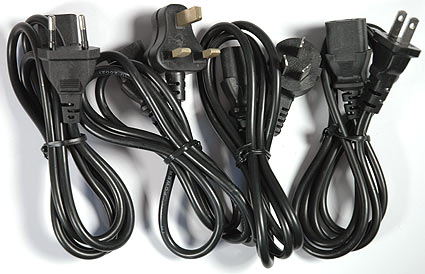
Brando included several different power plugs so that the adapter can be sold and used in almost any country.
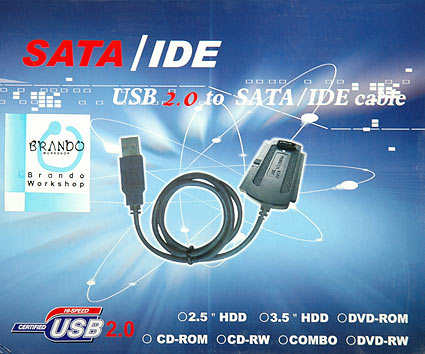
Hard drives with a sata interface are still the most capacious storage devices on the market. They are ideal for Reserve copy information, as well as for transferring large amounts of data when the speed of the Internet connection or the capacity of devices with Flash memory is not enough.
However, stationary hard disks, installed inside the computer case, are designed for sata interface, and are connected directly to the motherboard. This method is associated with several difficulties, moreover, it is impossible on laptops, while connecting a sata hdd via usb is no problem to any modern PC.
Let's talk a little about computer terminology in Russian. Sata is the name of the most common controller interface hard drives(“hard drives”, hdd). Previously, the ata (ide) standard was also used, but is now considered obsolete. A controller is a device that controls the drive. Usually it is located directly on the computer’s motherboard; therefore, to physically access it, you need to disassemble the PC case. But in many cases this is redundant, and laptops do not have standard means for connecting additional hard drives.
However, these difficulties can be solved by using a USB port (universal serial bus - that is, “universal serial bus"), which is equipped with any modern PC. How to hdd over usb? This can be done using special external sata controllers (adapters) that convert sata signals to usb.
Since you can connect a hdd via USB to any computer, the method is universal. In particular, it allows:
1. Use HDD on a laptop, net-top or all-in-one PC
Many modern users prefer traditional full-size system units (so-called “desktops”) different kinds portable or compact computers, such as laptops. Other popular form factors are mono-blocks (the system unit and monitor are combined into one device) and net-tops (small system units the size of a thick book). The advantages of these types of PCs are obvious: they are easy to transport, they make less noise, take up little space, and so on. But their compactness completely eliminates the installation of new devices inside the case. For owners of such computers, an external USB controller can be useful for copying large amounts of information and creating backup copies, since connecting a sata hdd via usb is the only way to use a sata disk in such a system.
2. Connect the drive without disassembling the desktop computer case
With a USB controller, you don't have to disassemble your computer case to . This will save you from unnecessary operations and simplify the process of copying information. Also, an external controller is indispensable in cases where it is not possible to remove the casing: the necessary tools are missing, the system unit is under warranty, or it is a sealed computer in the organization, which is prohibited from opening.
3. Connect an old hard drive with an outdated ata (ide) interface to modern computer, on the mother card of which there is no controller for this interface
Availability of an ata (ide) controller on modern motherboards- rare. But what if you need to copy some information from an old hard drive, for example, ten years ago? There are ATA controllers that are installed inside the case, but we recommend using a USB adapter for these purposes, since connecting an HDD via USB to copy information from an old device is easier and more convenient than installing an additional component on the motherboard.
Types of adapters that allow you to connect hdd via usb
There are a large number of manufacturers producing external controllers for drives, but the variety of models can be divided into two types:
1. External box
External boxes They are a special case into which a sata hard drive is placed. Such devices are largely designed for constant use. For example, when you need to increase the amount of free information on a net-top. External boxes allow you to secure the hard drive with bolts for reliability and close it with a protective cover. Accordingly, frequent replacement of the drive is not provided. An example of such a form factor is the DEXP BS-U35YA U3 model.
2.Adapter
This design does not provide for fixing the drive in the housing. Adapters are used for short-term use: for example, when you need to connect a hard drive to a laptop, copy the necessary information and disconnect it. This form factor is more compact, which is convenient for transportation. It is better suited for frequent changes of connected drives (for example, in computer services or departments). technical support). Also, unlike external boxes, which are designed for one type of interface, adapters can provide the ability to connect hard drives of different standards: 2.5”, 3.5” sata and ide (for example, the AGESTAR FUBCP model).
How to properly connect sata hdd via usb adapter
- Connect the hard drive to the adapter.
- Connect the power supply to the drive.
- Connect the power supply to a 220 V network.
- Connect the adapter to the PC's USB port. The operating system must detect the new device and provide access to the drive partitions.
Disconnection procedure
- Use the " safe shutdown devices" in operating system to stop the disk.
- Disconnect the adapter from the PC.
- Disconnect the power supply from the 220 V network.
- Disconnect the hard drive from the adapter.
The correct procedure for connecting and disconnecting ensures the safety of the drive and the information on it.
Connection hard drive(hard drive) via USB
Hello, dear readers! Let's make it clear right away - I am not involved in advertising for the manufacturer. I'm just talking about specific device, its configuration and functionality. So, in this article we will find out how to connect.
Introduction
I'm almost sure that most people on planet Earth know what a flash drive is. And some of you even have several of them. Well, for those who don’t know, I’ll explain, this is a small thing that needs to be connected to a USB connector devices. This could be a personal computer, TV, DVD player, car radio, etc. And depending on the volume of her memory, copy from her (or onto her) the information we need.
Well, to be honest, they are very convenient devices. True, there is one drawback. Flash drives differ from simple hard drives primarily in memory capacity. As you understand, the hard drive has many times more. The size of USB flash drives is measured in gigabytes. Currently, flash drives with capacities up to 256 GB are already on sale. This is of course good, but the sizes of hard drives reach several TB. Do you feel the difference?
What to do if you need to move a large amount of information from one hard drive personal computer another? Of course, you can use a standard flash drive. True, for this you will have to rush from one computer to another several times. But what if the second computer is located at the other end of the city? There is another solution for this.
How to connect?
Can be connected HDD via USB, using a USB 2.0 adapter to connect UltraATA and SATA 2.5 HDD, 3.5 HDD (hard drives). Its price, compared to large-capacity flash drives or an external hard drive, is relatively small - about 800 rubles. For comparison, Flash 32GB Transcend Jet Flash 300 costs about 1,500 rubles.
The USB 2.0 adapter is packaged in an elegant cardboard box, on the front side of which there are colorful drawings with inscriptions that help users navigate the capabilities of the device. Inside the box are the adapter power supply with power cords, the required adapter cables and a CD with software for USB1.1 protocol and "User's Manual".
As practice shows, when working with Windows XP, you do not need to install any additional software. Hard drives with a capacity of 400 and 500 GB were detected by computers and worked normally. The adapter connector has 3 colored LEDs (2 green and 1 red - IDE/Busy, SATA and USB), which indicate when the device is connected and working.
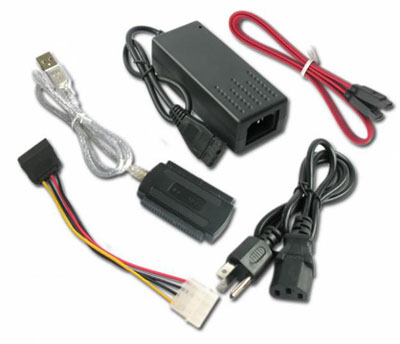
Principle of operation
Principle work pretty simple. First, you need to connect the device according to the scheme in which you use a hard drive, then connect the power supply to a 220V network, and the USB connector to the corresponding port of a PC or other device and use a large-capacity hard drive as a simple flash drive.
And there is no need to open system units, take out and insert hard drives back and forth. Convenience is obvious without words. The main thing is to never forget to disconnect the USB device when you are finished. And let this small but very useful device be your assistant in any situation.



